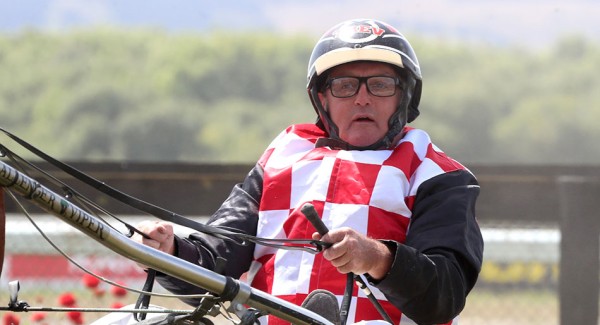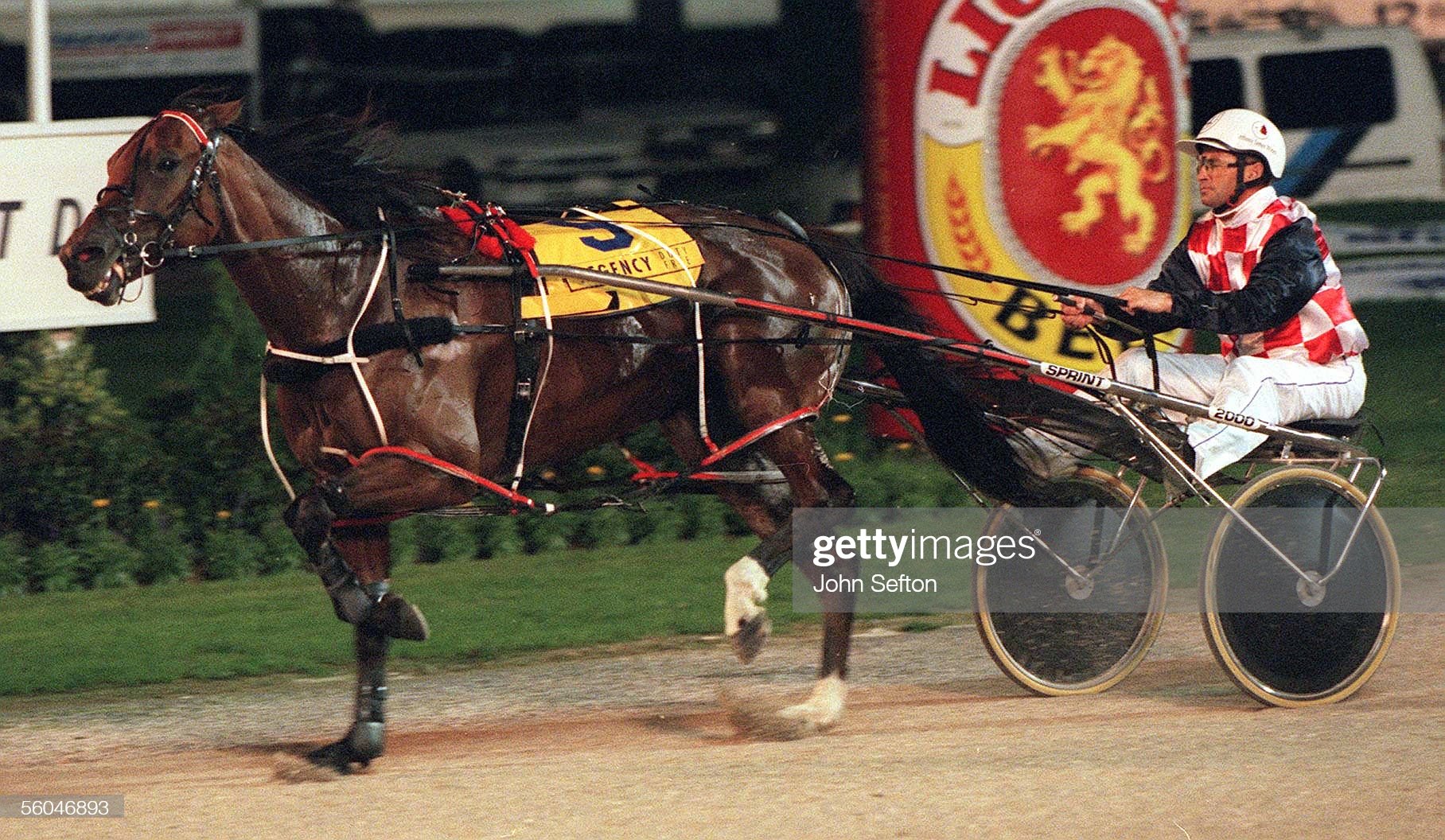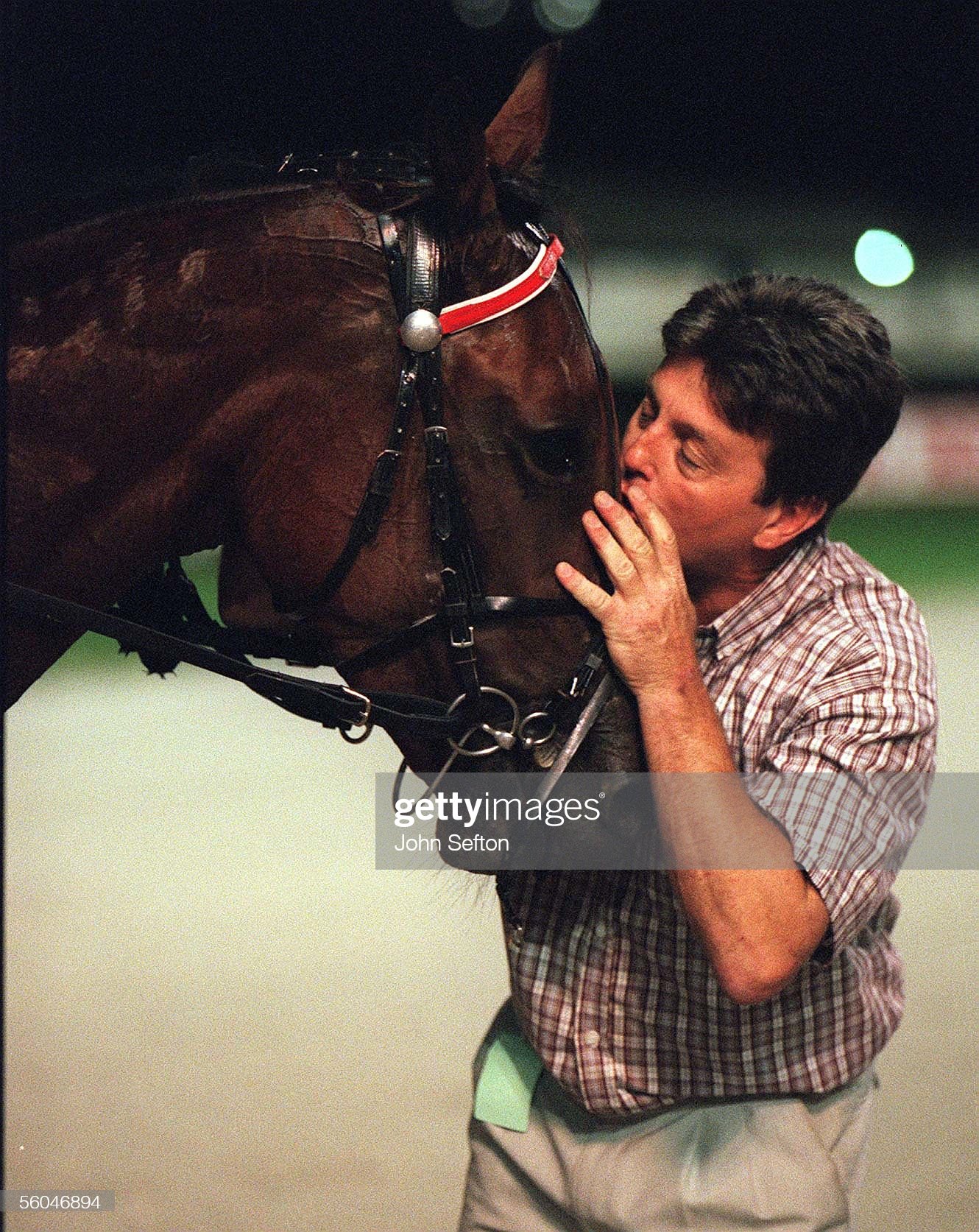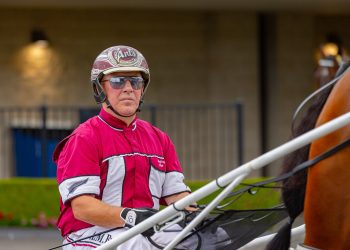It doesn’t get much better than Group One racing at headquarters, and tomorrow night (Mar. 31) will see some of New Zealand harness racing’s elite trotters do battle in the 59th edition of the Fred Shaw New Zealand Trotting Championships at Addington Raceway.
On what we have seen from the Greg and Nina Hope trained Muscle Mountain (Muscle Hill) in the last 12 months, only bad luck could stop the trotting superstar from claiming his second installment of the feature trot.
That is no blight on the other nine runners which includes a former New Zealand Trotting FFA winner in Oscar Bonavena (Majestic Son), the ever-consistent Midnight Dash (Muscle Hill) and the progressive Aardiebythehill (Muscle Hill). But without the likes of Sundees Son, Bolt For Brilliance and even Five Wise Men, the once deep trotting ranks are quite simply Muscle Mountain’s for the taking.
With that being said, it hasn’t stopped Rangiora horseman, Trevor Grant, from having a throw at the stumps with his old war horse, Rachmaninov (Diedre Don).
The eight-year-old is a staggering 87 rating points behind the $1.20 favourite, but unperturbed, Grant has a refreshing perspective for why the son of Diedre Don will line up for his 192nd start in an Open Class Group One.
“I won’t have to get nervous tomorrow, I think our fate is pretty much cut,” he laughed.
“Muscle Mountain is a wonderful horse and Ben and the Hope’s do a bloody good job and I am thrilled for them. But I get disappointed when I see these Free For All races struggling to get numbers. There are probably seven hundred better trotters then Rachmaninov in the country, and yet they refuse to nominate them.
“It’s a $90,000 race and there are people bitching and moaning about what’s happened to the stake money. Here you have my old clown whose eight years old who will run round and collect a nice bit of stake for his troubles. He won’t disgrace himself and I hope to finish within twenty lengths of them, and if they go along a bit, he will run the quickest race of his life and that is all you can ask, isn’t it?” he said.

Honestly, I rate that from Trevor. He has every right to line up a horse he co-bred, trains and owns if the conditions permit, and God knows we could use a few more like him growing a pair and running in races they are eligible for. What has he got to lose?
For Grant, it really is about principle more than sentiment, as this isn’t the first Group One rodeo for either horse or trainer. Rachmaninov was also tenth of 14 runners when contesting the G1 NZ Trotting Derby almost five years ago to the day, where he finished 15 lengths from the winner.
“He won two races as a three-year-old and because he had so many starts, he qualified for the Jewels at Cambridge the year Winterfell won, so that was a bit of fun. He didn’t finish with a few of the others making mistakes,” laughed Grant.
In more recent times, Rachmaninov has twice contested the G3 Summer FFA against Muscle Mountain and co finishing sixth of six both times, but a commendable 12 lengths from the winner given his rating and the fact ‘MM’ has trotted a 1:58.3-mile rate and ripped home in 55.6.
For Grant, should the unthinkable happen and Navel Officer’s 1984 NZ Derby unfold before our eyes, it wouldn’t be his first Group One success as a trainer.
Plenty will remember the heroics of the bonnie mare, Adio Routine (Equitable II), and her win in the G1 NZ Breeders Stakes at Addington in 1997. The two-time New Zealand mare of the year has a remarkable story, much like that of the unassuming Grant.
“I had been going to the races with Mum and Dad for the night races with all the lights and glamour back when there were crowds and occasionally me and my brother use to borrow the family Morris Miner and attend the odd meeting. I’m the second oldest of a big catholic family from Aranui so we didn’t have much of a trotting pedigree,” he said.
“When I started as a nurse at Sunny Side, I was in the same psychiatric nursing class as Gavin Burgess. We nursed together for 10 years or so and we were both charge nurses there at an early age. Gav’s father, Lester Burgess trained a few horses, and he was good mates with Kevin and Bonnie Williams.
“Once I started going out to Lesters place he had me sitting on a sulky with a wide seat and jogging round the paddock, I guess you could say that’s where it started. Kevin Williams had Master Mood when I first started going down, so it was hard not to be hooked seeing a horse like him in work.,” he said.
“Gavin Burgess rang me one day and said I have a horse you might be able to potter around with. His owners didn’t want to go own with her because she was needing a bit of time. He had four two-year-old fillies, and she was the worst of them at that stage and she was a tough steer. Her name was Adio Routine.”
Grant was still in his infancy as a trainer but realized pretty quickly there was bit more under the hood then what he had previously been accustomed to working with.
“I arranged a pretty reasonable right of purchase with the lease, and the first time I drove her I remember thinking f*%$ this is a damn sight better than anything I’d ever driven,” he laughed.

“I had her working home in a quarter in 29 and she was running all over the show, and I wasn’t very experienced at the time. So, I took her to Fred Fletcher, and he found she had some issues with her neck and spine. He equated it being the same as running around with a migraine all the time which is why she would be so intense when she was in work. Once we got that sorted, she started improving,” he said somewhat understated.
Adio Routine won her first start at Ashburton in 1996 as a three-year-old filly with Grant in the sulky.
It was just his second race day driving success having a year earlier driven Rachmaninov’s grand dam, Bo Rose to victory at Westport.
It wasn’t long before the likes of Maurice McKendry, Tony Herlihy and Colin DeFillipi were all sitting behind the daughter of Equitable II, with the latter steering her to a maiden G1 less than 12 months after she had cleared maidens.
“The emotions, well my family was there. Mum and Dad and my eight brothers and sisters,” he said.
“We ran second to New Age Man a week later in the G2 4YO Championship and then we ran second to Agua Caliente in the G1 Messenger. When he was on, nothing was beating him. Not even Christian Cullen in my view. There were some pretty good horses running around at that time,” he said.
Adio Routine retired with a quarter of a million dollars to her name and took Grant on the ride of a lifetime including four trips to Australia where she won the G2 Queen of the Pacific at Moonee Valley. Among her 15 race wins was also the G2 Premiere Mares Championships and the then Listed Queen of Hearts.
Grant rues the fact she missed away in Christian Cullen’s 1998 New Zealand Cup, and the fact she was desperately unlucky in finishing 4th behind Our Sir Vancelot in the Interdominion Pacing Final at Alexandra Park in 1999.
“She was primed to run a sub four minute two miles that day. They walked and she never got a fair crack at them, but we had a lot of fun with her,” he said.
While a lot of enthusiasts will remember the success Grant shared with Adio Routine, there will be plenty tuning in tomorrow night blissfully unaware. So, for the young newcomers, the casual followers or the uneducated among us, give Trevor Grant his dues.
If a largely self-taught hobby trainer, who educated a G1 winner while holding down a career in a field as grueling as psychiatric care wants to start a rating 37 in a G1 race, power to him.
After all, Rachmaninov is from a family he began developing long before his breakthrough success with Adio Routine and extends back to the early 90’s with a mare called Bo Rose (Bo Scot’s Clue Chip).
“When I was living in Motukarara and had just started my training career pottering around with a few, Mike McKellar was the track manager out there and he trained a couple of horses as well.
“He had this mare called Bo Rose who he didn’t really want to press on with, so I leased her with a very reasonable right of purchase. She had a chip in her knee so sometimes she would go pretty well if the bone chip wasn’t annoying her, and she always went pretty good on the grass and managed to win a race.
“I had my good mare who was by the Equitable II and had just qualified her earlier that week going eight seconds under time and winning by eight lengths. I rang Phillip Iggo who was standing the stallion at the time and took Bo Rose round to his place to be served.
“That produced the first foal, Rusty Pelican who was a heck of a nice gelding but of course in those days you went up the grades and never came back down them. When he got to C4 he couldn’t progress much further, but strangely enough he became the Gold Coast horse of the year as a nine-year-old and went 1:56 which was pretty quick in those days.
“By the time we bred the second one from the mare, Adio Routine was starting to earn some money. She paid for a lot that went on around that time and a lot that has gone on afterwards,” he said.
The winning cheques of Adios Routine afforded Grant the resources to serve Bo Rose with two of the flashiest shuttle stallions to reach New Zealand shores with Falcon Seelster and In The Pocket chosen as the final two consorts before her passing.

“The second foal, Minstrel Dawn (Falcon Seelster) was tough, really tough. We went to Auckland with her and raced in a non-tote two-year-old race and she went good enough to qualify but it was a wet night and when she came back, she couldn’t walk afterwards. We took her back to Pukekohe and took her to the vets on the Monday and realized she had fractured her sesamoid. We got her back after cutting a big chunk of it and she won two races, but she used to race with trotting boots on her back legs to give them some support.
“She went from the back at Addington one time, sat parked and won and at her next start went round them and lead and won again. She was a lovely mare but eventually she succumb to the same injury,” he said.
Then along came the dam of Rachmaninov in Starwood In Aspen (In The Pocket).
The dual gaited mare who began her career pacing was very much cut from the same cloth as her youngest son, having raced 126 times from the age of two until she was nine.
“They are tough this breed, they aren’t quick and that probably came from the Bo Scot Blue Chip of Bo Rose. She wasn’t quick enough and didn’t have any speed to be a good pacer, but she won a couple of races in that gait,” he said.
So how did a family with little to no trotting bloodlines to speak of wind up as one of only five NZ bred winning trotters for her legendary sire?
“You might have heard of a guy called Derek Jones,” laughed Grant.
“I was helping Derek with some of his horses, he probably had ten in work so between the two of us we would get through the day’s work and have some fun.
“I asked him to drive Starwood In Aspen and go with her in front while I worked the older sister, Minstrel Of The Dawn. ‘Aspen’ set off into a trot, and as we were going along, I kept looking up and the further we went she was still in a trot. We got to the mile and a half, and she had never broken out of the gait,” he laughed.
“It was only when I rolled up alongside her that she rolled into a gallop, and she had worked the mile and a half in 3:20 before we knew she was a trotter. We thought it was a great laugh at the time,” he said.
“She won a race at Blenheim where she led out of the gate and she just hung on after we made it too tough for them. She was much like Rachmaninov, she didn’t have any speed but if they rolled along a bit and she didn’t have to run a sharp last quarter, she was more than capable of being there at the finish,” he said.
As you can see, we covered some territory but one thing I failed to realise before finishing our conversation was why given the mare was better suited to trotting, did she race two thirds of her career as a pacer? Her last 32 starts were wearing a pair of hopples and this was after winning four races as a square gaiter.
Nevertheless, she was to be bred from by Grant and connections, carving out a reasonably successful career to date.
Her first foal was a son of Brylin Boyz in Young Stranger who eclipsed his dam in number of race starts by two (128 in total) and raced from the age of two until he was ten.
He was the winner of nine and had 19 placings before his retirement in 2020.
“He was a big bugger, about 17 hands, and he was blind in his near side eye. We had to get him one of the newer carts because he would swing his near side hind leg wide, so he didn’t have much going for him.
“He had some real power, but he could just panic at times, probably due to being blind in one eye. He probably had the rawest speed and power of her three trotting foals, but he was just a bit temperamental,” said Grant.
Grant and his co-breeders sent Starwood In Aspen to the full brother of Mach Three in Extreme Three for two foals who qualified and started on race day without much success.
Wedged in between the pair was tomorrow night’s G1 starter, Rachmaninov.
“He didn’t show me much as a young horse and never has to be honest, were just going round because that’s what you do. I believe you’ve got a racehorse and they should be racing and that was part of his education.
“It’s been a good education though. He has had close to 200 starts and the Methven run recently was the first time in his career since he was a two-year-old that he has broken free of interference,” he laughed.
“He’s just happy and enjoying his work at the moment. I wouldn’t be lining him up tomorrow night if I thought it would do him any harm. With horses, its only something minuscule that has to be touching or them to be feeling and they race accordingly. I’ve found ways to work with the individual. Even at eight years old they can change for the better or the worse, and like a lot of trotters, if they are trotting well, they just keep trotting. That is the zone he is in at the moment,” he said.
RACHMANINOV REPLAY
Starwood In Aspen passed away last year at the ripe old age of 23.
In 2019 she left Grant a now three-year-old filly by Royal Aspirations who might looks capable of adding to the winning foal tally which currently sits at two.
“We might be able to make that three. Since we came out to Rangiora she has only ever trained on her own. She just seems ordinary in the work she does at home, but she tries hard and has a nice way of going, but I only have a wee track here. When I have gone to other people’s places, she has shown a great turn of foot.
“She has had a couple of workouts now and she ran second in her first trial at the start of the month after blowing the start. She went under the time but didn’t get her ticket as a result. It was a pretty nice run and there is potential with her, but you don’t want to get ahead of yourself,” he said.
Grant has an almost self-deprecating way of making sure expectations are met with reality.
And although his recent involvement in the sport hasn’t quite measured up to the glamour of the Adio Routine days, it hasn’t stopped him from doing what he loves in the pursuit of that elusive great horse.
Rachmaninov might not be everyone’s definition of a Group One performer but take nothing away from him and his breeder/owner/trainer/driver who at the age of 69 is out there living his best life and doing what he loves.
“The thing I love about this sport having played a lot of competitive sport in my life is that this gets your adrenaline going again,” said Grant.
“Strangely enough, having said that, I get more nervous on my way to the races and when I’m standing around gearing up then when I’m out on the track. Once I’m out there warming up, I feel good as gold and it will be good fun tomorrow night,” he added.
For complete Addington race fields, click here.
by Brad Reid, for Harnesslink

 USA
USA Canada
Canada Australia
Australia New Zealand
New Zealand Europe
Europe UK / IRE
UK / IRE



